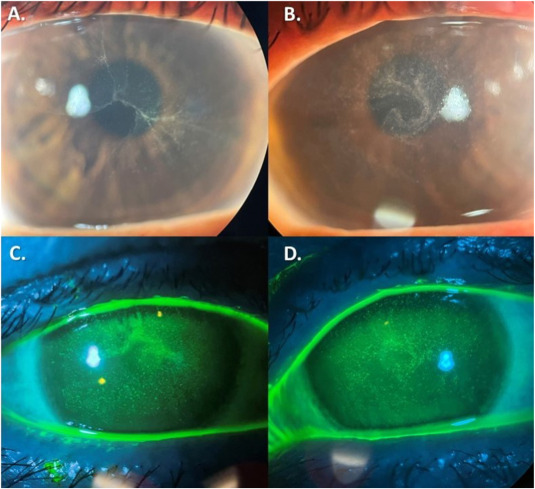Punctate epithelial keratopathy (PEK), also known as superficial punctate keratitis (SPK), is a condition characterized by small, dot-like defects or lesions in the corneal epithelium. These lesions are often visible through fluorescein staining during slit-lamp examination and are associated with various ocular surface disorders. Though typically non-infectious, PEK may cause significant ocular discomfort and visual disturbances if left untreated.

Pathophysiology and Etiology of PEK
PEK represents damage or death of the superficial epithelial cells of the cornea. The condition arises due to the disruption of the ocular surface integrity, which may result from a wide spectrum of underlying causes.
Common Etiological Factors
- Dry Eye Syndrome: The leading cause of PEK, due to tear film instability and inflammation.
- Contact Lens Wear: Mechanical trauma and hypoxia from extended wear.
- Chemical or UV Exposure: Includes pollutants, preservatives in eye drops, or photokeratitis.
- Infectious Keratitis: Especially viral (e.g., herpes simplex, adenovirus) infections.
- Blepharitis or Meibomian Gland Dysfunction: Affects the lipid layer of the tear film.
- Topical Medications: Prolonged use of eye drops containing benzalkonium chloride.
- Systemic Diseases: Such as Stevens-Johnson syndrome or graft-versus-host disease.
Clinical Presentation and Symptomatology
Patients with punctate epithelial keratopathy typically report:
- Foreign body sensation
- Photophobia
- Burning or stinging pain
- Excessive tearing (epiphora)
- Blurred or fluctuating vision
- Mild redness
Symptoms may be bilateral or unilateral depending on the cause, with symptom severity not always correlating with the extent of epithelial involvement.
Diagnostic Evaluation of Corneal Epitheliopathy
An accurate diagnosis of PEK involves clinical examination and exclusion of more serious corneal pathologies.
Staining Patterns
- Fluorescein: Highlights epithelial defects as bright green dots.
- Rose Bengal or Lissamine Green: Useful for detecting devitalized cells and mucin-deficient areas.
Differential Diagnosis
Differentiating PEK from other causes of superficial keratitis is essential to avoid inappropriate treatment.
| Condition | Key Features |
|---|---|
| Viral Keratitis | Unilateral, dendritic lesions (HSV) or coarse lesions (adenovirus) |
| Thygeson’s SPK | Bilateral, chronic, non-infectious, with minimal redness |
| Exposure Keratopathy | Inferior staining due to incomplete lid closure |
| Toxic Keratopathy | Diffuse staining, often linked to topical drops |
Therapeutic Strategies for Punctate Epithelial Keratopathy
Treatment of PEK is based on identifying and addressing the underlying cause, alongside symptomatic relief.
General Management Approaches
- Lubrication: Preservative-free artificial tears to stabilize tear film and promote healing.
- Discontinuation of Offending Agents: Especially topical medications with preservatives.
- Protective Measures: Use of protective eyewear, humidifiers, or punctal plugs in dry environments.
Etiology-Specific Treatments
- Dry Eye Disease: Cyclosporine eye drops, lifitegrast, or autologous serum tears.
- Blepharitis: Lid hygiene, warm compresses, and topical or oral antibiotics (e.g., doxycycline).
- Viral Etiologies: Antivirals such as ganciclovir gel or oral acyclovir.
- Contact Lens-Related: Temporary discontinuation and switch to daily disposable lenses.
Advanced Therapies
- Bandage Contact Lenses: For severe epithelial breakdown or neurotrophic corneas.
- Amniotic Membrane Transplantation: In recalcitrant or chronic epithelial defects.
- Tarsorrhaphy: For exposure-related PEK in patients with facial palsy or severe lagophthalmos.
Prognosis and Complications
With prompt treatment and elimination of the underlying cause, PEK typically resolves without lasting damage. However, chronic or recurrent cases may lead to:
- Recurrent corneal erosions
- Corneal neovascularization
- Persistent epithelial defects
- Decreased visual acuity
Prevention of Recurrent Punctate Epithelial Keratopathy
Preventative strategies are integral in reducing the recurrence of PEK, particularly in individuals with chronic ocular surface disease.
Long-Term Management Tips
- Regular use of preservative-free lubricants
- Avoidance of known triggers (e.g., environmental irritants)
- Periodic evaluation of contact lens hygiene
- Management of systemic diseases contributing to dry eye or exposure
Punctate epithelial keratopathy is a multifactorial condition with a wide range of potential causes, from mild dry eye to serious systemic disease. Accurate diagnosis and targeted treatment are critical for effective resolution and the prevention of recurrence. A comprehensive approach—encompassing ocular surface protection, inflammation control, and patient education—is essential to maintain long-term ocular health.

